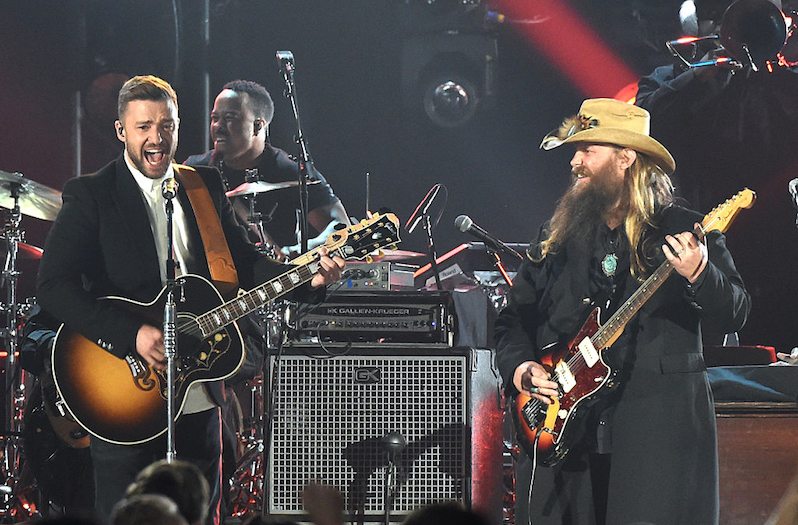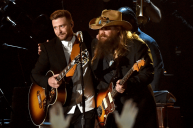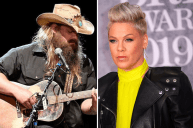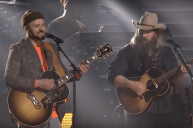Just over two years ago, Justin Timberlake joined Chris Stapleton onstage at the CMA Awards for one of the most memorable duets in the award show's history. It was Stapleton's moment, but it was also an opportunity for the Memphis-born Timberlake to showcase his country and soul roots.
Since then, rumors of Timberlake "going country" have been swirling. Last week, the country buzz was further fueled by the mountain man aesthetic of the album art and teaser video for Timberlake's upcoming album Man of the Woods. When Timberlake dropped the EDM-inspired "Filthy," fans were left wondering whether the country vibes are over-hyped or if Man of the Woods is just a concept album in which Justin is transported from a robotics expo into a Patagonia catalog. That all remains to be seen. But one thing is clear: pop stars have fallen in love with country music. Or at least the country image.
Country's slow march toward pop has been well documented — from the polished, cosmopolitan Nashville Sound to the Urban Cowboy craze of the 80s to the bubble gum pop-country of Taylor Swift. But as country stars trade in their Stetsons for snapbacks, more and more pop stars are looking to Music City for a new start.
In the last two years Lady Gaga, Ariana Grande, Katy Perry and Miley Cyrus have either expressed interest in recording country or released country-inspired tracks. A year after Timberlake, Beyonce took her rootsy revenge track "Daddy Lessons" to the CMA stage in a performance with the Dixie Chicks. The act was met with both praise and anger. How could one performance cause such strong and varying reactions? To understand, you have to look back at the history of the relationship between country and pop.
The Country and Pop Dynamic
From the very beginning, the idea of what is "country" has been up for debate. The genre itself derived from folk music and the blues. In 1930, the father of country music, Jimmie Rodgers, collaborated with jazz legend Louis Armstrong on "Blue Yodel #9," one of the most formative songs in country music history. And when Billboard rolled out its first country chart in 1944, the first artists to hit No. 1 were Bing Crosby and the Andrews Sisters. Ray Charles' groundbreaking 1962 album Modern Sounds in Country and Western Music is seen as a landmark album of American music.
But as pop continued to merge with country over the years, some saw it as a threat to the sanctity of country music. In 1974, Olivia Newton John took home the CMA award for Female Vocalist of the Year. In response, George Jones, Tammy Wynette and Jean Shepard formed the Association of Country Entertainers (ACE) to combat pop's country music infiltration.
ACE didn't have much impact. The following year, John Denver was awarded the CMA for Entertainer of the Year. When country artist Charlie Rich announced Denver's win, he set the envelope on fire in one of the most infamous moments in country history. Many saw the act as a shot at Denver and the increasing pop-ification of country. Even the man who sang "Thank God I'm a Country Boy" and "Take Me Home Country Roads" wasn't fully embraced.
https://www.youtube.com/watch?v=OGkbdLsBRrY
It's a far cry from today. Just last month, pop artist Bebe Rexha became the first woman to debut at No. 1 on the Billboard country charts with her song "Meant to Be," featuring Florida Georgia Line.
So what drives pop stars to country? In some cases, it may be a deep and abiding love for the genre. In other cases, it may be good old-fashioned money and staying power. Sometimes going country is just a good business decision. Why? For one, country fans still buy music. According to a study by Nielsen Music, 63 percent of country album sales come from CD purchases. Country fans also tend to be older. In 2011, Billboard reported that the average country fan is 45 years old. While pop audiences are fleeting, country radio and country fans will still be there when the latest (and youngest) pop star comes along to steal the spotlight.
Country Roots, Pop Grooves
But country is more than just wearing a cowboy hat and vintage Manuel. There's a difference between taking inspiration from classic country and topping the country charts with a full-fledged pop song.
Throughout the latter 20th century, pop and folk-rock artists like Linda Ronstadt and Bob Dylan proved themselves to be master interpreters of country songs. Just look at the long line of pop and rock artists who appeared on The Johnny Cash Show.
Modern day artists have shown their ability to take inspiration from country music while remaining true to their on artistry. Beyonce's "Daddy Lessons," a whiskey-fueled southern family saga, sounds like a lost Bobbie Gentry jam or a modern day Miranda Lambert collaboration. Even if you don't compare it to the output of Florida Georgia Line, "Daddy Lessons" is pretty damn country. Nashville-native Kesha expertly blended country-folk with pop on her 2017 album Rainbow and showcased her Tennessee roots on the Dolly Parton collaboration "Old Flames (Can't Hold a Candle to You)." (Kesha's mother, Pebe Sebert, wrote "Old Flames" in 1978.)
Country music plays an important role in the history of American music. As pop artists move into the country realm, it could be an opportunity to showcase what makes country music unique again. And when it comes to Timberlake and his fellow pop stars, it wouldn't hurt to listen before we light the envelope on fire.




